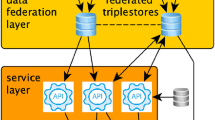Abstract
Relationships between the journal download immediacy index (DII) and some citation indicators are studied. The Chinese full-text database CNKI is used for data collection. Results suggest that the DII can be considered as an independent indicator, but that it also has predictive value for other indicators, such as a journal’s h-index. In case a journal cannot yet have an impact factor—because its citation history within the database is too short—the DII can be used for a preliminary evaluation. The article provides results related to the CNKI database as a whole and additionally, some detailed information about agricultural and forestry journals.







Similar content being viewed by others
References
Bollen, J., & Van de Sompel, H. (2008). Usage impact factor: The effects of sample characteristics on usage-based impact metrics. Journal of the American Association for Information Science and Technology, 59(1), 136–149.
Brody, T., Harnad, S., & Carr, L. (2006). Earlier web usage statistics as predictors of later citation impact. Journal of the American Association for Information Science and Technology, 57(8), 1060–1072.
Fowler, D. C. (Ed.). (2007). Usage statistics of E-serials. Binghamton: Haworth Information Press.
Frazier, K. (2001). The librarian’s dilemma: Contemplating the costs of the “Big Deal”. D-Lib Magazine, Vol. 7(3). http://www.dlib.org/dlib/march01/frazier/03frazier.html.
Harnad, S., & Brody, T. (2004). Prior evidence that downloads predict citations. BMJ Rapid Responses. Retrieved September 6, 2004 from http://bmj.bmjjournals.com/cgi/eletters/329/7465/546#73000.
Hirsch, J. E. (2005). An index to quantify an individual’s scientific research output. Proceedings of the National Academy of Sciences, 102(46), 16569–16572.
Hua, P. H., Rousseau, R., Sun, X. K., & Wan, J. K. (2009). A download h (2)-index as a meaningful usage indicator of academic journals. In B. Larsen & J. Leta (Eds.), Proceedings of ISSI 2009 (pp. 587–596). Rio de Janeiro: BIREME/PAHO/WHO and Federal University of Rio de Janeiro.
Jin, B. H., Li, L., & Rousseau, R. (2003). Production and productivity of Chinese scientists as a function of their age: the period 1995–1999. In G. Jiang, R. Rousseau, & Y. Wu (Eds.), Proceedings of the 9th international conference on scientometrics and informetrics (pp. 112–120). Dalian: Dalian University of Technology Press.
Nicholas, D., Huntington, P., & Watkinson, A. (2003). Digital journals, Big Deals and online searching behaviour: A pilot study. Aslib Proceedings, 55(1/2), 84–109.
Perneger, T. V. (2004). Relation between online “hit counts” and subsequent citations: prospective study of research papers in the BMJ. BMJ, 329(7465), 546–547.
Ren, S. L., & Rousseau, R. (2004). The role of China’s English-language scientific journals in scientific communication. Learned Publishing, 17, 99–104.
Rousseau, R. (2002). Journal evaluation: Technical and practical issues. Library Trends, 50(3), 418–439.
Schloegl, C., & Gorraiz, J. (2008). Comparison of citation and usage indicators: The case of oncology journals. In J. Gorraiz & E. Schiebel (Eds.), Excellence and emergence, book of abstracts, 10th international conference on science and technology indicators (pp. 98–102). Vienna: Austrian Research Centers GmbH–ARC.
van Raan, A. F. J. (2006). Comparison of the Hirsch-index with standard bibliometric indicators and with peer judgment for 147 chemistry research groups. Scientometrics, 67(3), 491–502.
Wan, J. K., Hua, P. H., Du, J., & Song, H. M. (2007). Focus on the front of scientific evaluation, putting new indicators into practice: Three new bibliometric indicators adopted by China Academic Journals Comprehensive Citation Report, Digital Library Forum (in Chinese), issue 3, pp. 36–41.
Wan, J. K., Hua, P. H., & Sun, X. K. (2005). Bibliometrics analysis on cited frequency and downloaded frequency of journal papers. New Technology of Library and Information Service (in Chinese), 4, 58–62.
Wan, J. K., & Xue, F. Y. (2007). Chinese Academic Journals Comprehensive Citation Report. Beijing: Science Press.
Yue, W. P., Wilson, C. S., & Rousseau, R. (2004). The immediacy index and the journal impact factor: Two highly correlated derived measures/L’indice d’immédiateté et le facteur d’impact des périodiques: deux mesures dérivées fortement corrélées. Canadian Journal of Information and Library Science/La Revue canadienne des sciences de l’information et de bibliothéconomie, 28(1), 33–48.
Acknowledgements
Rousseau’s work was supported by the National Natural Science Foundation of China (NSFC Grant No 70673019). The authors thank Raf Guns (Antwerp University), Christian Schögl (University of Graz), Juan Gorraiz (University of Vienna) and two anonymous reviewers for helpful comments on an earlier version.
Author information
Authors and Affiliations
Corresponding author
Appendix
Appendix
In this appendix we present Table 5 in which the download immediacy index is compared to the CII, the classical impact factor, the total number of citations received and the h-index. All indices refer to the year 2006. This means that publications in the years 2004 and 2005 are used to determine the impact factor; publications in the year 2006 are used for the two immediacy indices. For ‘total number of citations received’ citations are received in 2006 and refer to publications over all years. Finally, the h-index is the 2006 h-index using publications during the period 2002–2006.
Rights and permissions
About this article
Cite this article
Wan, Jk., Hua, Ph., Rousseau, R. et al. The journal download immediacy index (DII): experiences using a Chinese full-text database. Scientometrics 82, 555–566 (2010). https://doi.org/10.1007/s11192-010-0171-2
Received:
Published:
Issue Date:
DOI: https://doi.org/10.1007/s11192-010-0171-2




